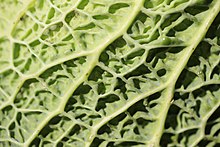
Kohlrabi, also called German turnip or turnip cabbage, is a biennial vegetable, a low, stout cultivar of wild cabbage. It is a cultivar of the same species as cabbage, broccoli, cauliflower, kale, Brussels sprouts, collard greens, Savoy cabbage, and gai lan.

The turnip or white turnip is a root vegetable commonly grown in temperate climates worldwide for its white, fleshy taproot. The word turnip is a compound of turn as in turned/rounded on a lathe and neep, derived from Latin napus, the word for the plant. Small, tender varieties are grown for human consumption, while larger varieties are grown as feed for livestock. In Northern England, Scotland, Ireland, Cornwall, Devon, and parts of Canada, the word turnip often refers to rutabaga, also known as swede, a larger, yellow root vegetable in the same genus (Brassica).

Cabbage, comprising several cultivars of Brassica oleracea, is a leafy green, red (purple), or white biennial plant grown as an annual vegetable crop for its dense-leaved heads. It is descended from the wild cabbage, and belongs to the "cole crops" or brassicas, meaning it is closely related to broccoli and cauliflower ; Brussels sprouts ; and Savoy cabbage.

Broccoli is an edible green plant in the cabbage family whose large flowering head, stalk and small associated leaves are eaten as a vegetable. Broccoli is classified in the Italica cultivar group of the species Brassica oleracea. Broccoli has large flower heads, usually dark green, arranged in a tree-like structure branching out from a thick stalk which is usually light green. The mass of flower heads is surrounded by leaves. Broccoli resembles cauliflower, which is a different but closely related cultivar group of the same Brassica species.

Cauliflower is one of several vegetables in the species Brassica oleracea in the genus Brassica, which is in the Brassicaceae family. It is an annual plant that reproduces by seed. Typically, only the head is eaten – the edible white flesh is sometimes called "curd". The cauliflower head is composed of a white inflorescence meristem. Cauliflower heads resemble those in broccoli, which differs in having flower buds as the edible portion. Brassica oleracea also includes broccoli, Brussels sprouts, cabbage, collard greens, and kale, collectively called "cole" crops, though they are of different cultivar groups.

The Brussels sprout is a member of the Gemmifera cultivar group of cabbages, grown for its edible buds. The leaf vegetables are typically 1.5–4.0 cm (0.6–1.6 in) in diameter and resemble miniature cabbages. The Brussels sprout has long been popular in Brussels, Belgium, from which it gained its name.
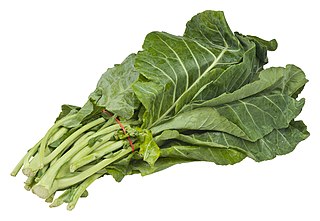
Collard is a group of certain loose-leafed cultivars of Brassica oleracea, the same species as many common vegetables including cabbage and broccoli. Collard is generally described as part of the Acephala (kale) cultivar group, but gets its own variety as Brassica oleracea var. viridis. The name "collard" comes from the word "colewort".

Kale, or leaf cabbage, belongs to a group of cabbage cultivars grown for their edible leaves, although some are used as ornamentals. Kale plants have green or purple leaves, and the central leaves do not form a head. Kales are considered to be closer to wild cabbage than most of the many domesticated forms of Brassica oleracea.
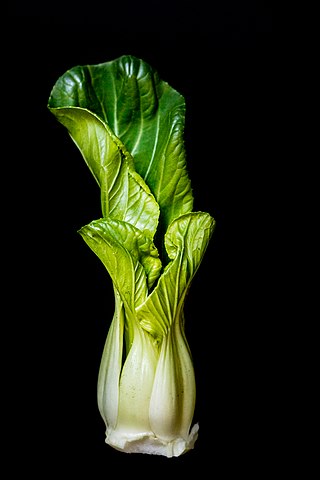
Bok choy, pak choi or pok choi is a type of Chinese cabbage, used as food. Chinensis varieties do not form heads and have green leaf blades with lighter bulbous bottoms instead, forming a cluster reminiscent of mustard greens. It has a flavor between spinach and water chestnuts but is slightly sweeter, with a mildly peppery undertone. The green leaves have a stronger flavor than the white bulb.

Brassica oleracea is a plant species from family Brassicaceae that includes many common cultivars used as vegetables, such as cabbage, broccoli, cauliflower, kale, Brussels sprouts, collard greens, Savoy cabbage, kohlrabi, and gai lan.

Leaf vegetables, also called leafy greens, pot herbs, vegetable greens, or simply greens, are plant leaves eaten as a vegetable, sometimes accompanied by tender petioles and shoots. Leaf vegetables eaten raw in a salad can be called salad greens.

The red cabbage is a kind of cabbage, also known as Blaukraut after preparation. Its leaves are colored dark red/purple. However, the plant changes its color according to the pH value of the soil due to a pigment belonging to anthocyanins. In acidic soils, the leaves grow more reddish; in neutral soils, they will grow more purple, while an alkaline soil will produce rather greenish-yellow colored cabbages. This explains the fact that the same plant is known by different colors in various regions. It can be found in all of Europe, throughout the Americas, in China, and especially in Africa.
Spring greens are a cultivar of Brassica oleracea in the cultivar acephala group, similar to kale, in which the central leaves do not form a head or form only a very loose one. It is considered to be closer to wild cabbage than most other domesticated forms, and is grown primarily in northern Europe, where its tolerance of cold winters is valued for an early spring supply of edible leaves. The cultivar group acephala also includes curly kale and collard greens, which are extremely similar genetically.
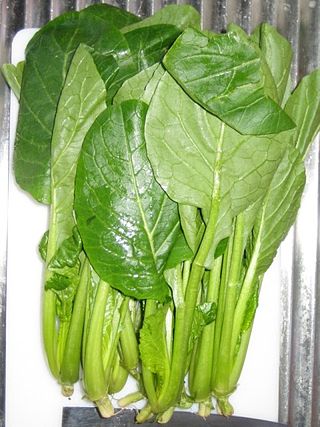
Komatsuna or Japanese mustard spinach is a leaf vegetable. It is a variety of Brassica rapa, the plant species that yields the turnip, mizuna, napa cabbage, and rapini. It is grown commercially in Japan and Taiwan. It is a versatile vegetable that is cooked and eaten in many ways. The plant is also used for fodder in some Asian countries.
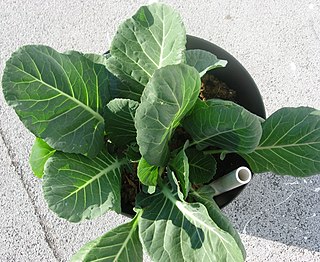
The acephala group refers to any type of Brassica which grows without the central 'head' typical of many varieties of cabbage. These are included within the species Brassica oleracea, such as kale. The name literally means "without a head" in contrast to those varieties known as capitata or "with a head". This group includes a number of species, both wild and cultivated, many of which are grown for their edible leaves and flowers.

Sukuma wiki is an East African dish made with collard greens, known as sukuma, cooked with onions and spices. It is often served and eaten with ugali.

January King cabbage is a cultivar with intermediate morphology between Savoy cabbage and white cabbage. It is known as chou de Milan de Pontoise in France.

Lacinato kale is variety of kale from the Acephala group of cultivars Brassica oleracea grown for its edible leaves. Lacinato or, in Italian and often in English, cavolo nero has a long tradition in Italian cuisine, especially that of Tuscany. It is also known as Tuscan kale, Italian kale, dinosaur kale, kale, flat back kale, palm tree kale, or black Tuscan palm. Lacinato kale has been grown in Tuscany for centuries, and is one of the traditional ingredients of minestrone and ribollita.
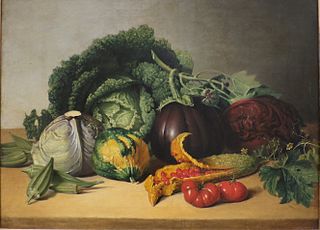
Still Life: Balsam Apple and Vegetables is an early 19th century oil painting by American painter James Peale. Done in oil on canvas, the painting depicts a number of vegetables set on a table. The work is currently on display at the Metropolitan Museum of Art. It is considered Peale's finest still life.



